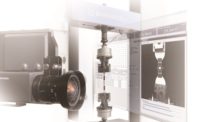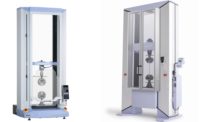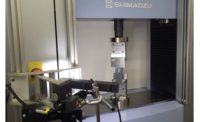Back to Basics: Compressive Testing for Rigid Plastics
An expert discuses compressive test methods and ASTM D695.

The specimen’s deformation is measured by a strain gage, or a compressometer, that measures the distance between two fixed points on the test specimen during the test, recording the change in distance caused by the load exerted on the specimen.
Pick up a material analysis data sheet and you’ll always find tensile testing, and probably flexural testing as well. But depending on the application, don’t hold your breath looking for compressive testing.
“Compressive testing is just a slower test,” explains Steve Driscoll, professor, department of plastics engineering, University of Massachusetts Lowell. “Instead of testing at 0.2 inches per minute and up to 20 inches per minute, it’s a very slow test at 0.05 inches per minute. It just takes longer.”
Of course, there are rigid plastic parts that will undergo compressive forces during their product life cycle. So measuring for modulus of elasticity, yield stress, deformation beyond yield point, and compressive strength is as important as any other common materials test when the application calls for it.
Resin makers, design engineers and manufacturers rely on these materials tests to ensure their processes are stable and consistent, and that the right material is used for the right application. It’s imperative for quality.
Standards
ASTM and other international organizations provide standards for compressive testing, but the focus here will be ASTM D695, the standard for compressive testing rigid plastics. Like all ASTM standards, it’s reviewed every five years to address questions posed by recent advancements in materials or technologies.
“ASTM D695 is not quite as old as ASTM D638 for tensile properties, but it predates flexural, which is D790,” Driscoll says. “But if you look at a compressive tests, there’s almost a dozen compression tests for plastics and elastomers, all sorts of cellular products, flooring applications, plastics and lumber applications.”
In compressive testing rigid plastics, a small specimen—usually a prism of 0.5 by 0.5 by 1 inch, or a cylinder with a diameter of 0.5 inch and a length of 1 inch—is placed between two hardened blocks, or plates, in a universal testing machine. Rather than pulling it apart like in a tensile test, the two blocks slowly compress the specimen until the point of fracture or distortion.
ASTM requires that test specimens are conditioned to the appropriate standard before testing, and that the test should take place in a room at the same temperature and humidity as the room used in conditioning. The standard also requires that with isotropic materials, at least five specimens are tested. For anisotropic materials, the standard requires at least 10 specimens, with five tested normally and five tested parallel with the principal axis of anisotropy.
ASTM notes that “materials possessing a low order of ductility may not exhibit a yield point. In the case of a material that fails in compression by a shattering fracture, the compressive strength has a very definite value. In the case of a material that does not fail in compression by a shattering fracture, the compressive strength is an arbitrary one depending upon the degree of distortion that is regarded as indicating complete failure of the material.
“Many plastic materials will continue to deform in compression until a flat disk is produced, the compressive stress (nominal) rising steadily in the process, without any well-defined fracture occurring,” ASTM continues. “Compressive strength can have no real meaning in such cases.”
The specimen’s deformation is measured by a strain gage, or a compressometer, that measures the distance between two fixed points on the test specimen during the test, recording the change in distance caused by the load exerted on the specimen.
Industry Specific
Driscoll notes that compressive testing is more routinely performed in the civil engineering department down the hall from his plastics engineering classroom. There, tests check the strength of concrete columns, steel beams, flooring and other construction materials that will be subjected to regular compressive forces. Construction is now the second largest market for plastic materials, he adds. And other common, every-day materials like packing foam, cushioning and shipping pallets are also regularly tested for their compressive properties.
“It’s very application- and industry-specific,” he says. “When you put 1,000 pounds of steel on a shipping pallet, or you put 1,000 pounds of resin on a shipping pallet, that’s a compressive test. Compressive testing is still very, very critical, just not as popular as tensile testing or flexural testing.
Compressive testing is also essential in checking the strength of materials with a “sandwich” construction, created by techniques such as elastic reservoir molding (ERM). Its proposed use in the ‘70s still hovers in the imaginations of design engineers thanks to the DeLorean DMC-12, the eccentric sports car made famous again years later as the time-traveling vehicle in Back to the Future. One of the key design characteristics that most intrigued investors during the car’s prototype stage was the proposed use of an unproven manufacturing technology known as elastic reservoir molding.
The ERM process used two outer fibrous glass layers to sandwich resin-impregnated inner foam, which was compressed to impregnate and then cured, according to Driscoll. This hidden sub-structure of the body panels was then to be bonded to the stainless steel outer skins. Unlike the more popular compression molded sheet molding compound (SMC), or hand-lay-up fibrous glass impregnated with unsaturated polyester resin used to manufacture the Corvette and Avanti body components, ERM did not achieve wide-spread economical and functional success.
Looking for a reprint of this article?
From high-res PDFs to custom plaques, order your copy today!






